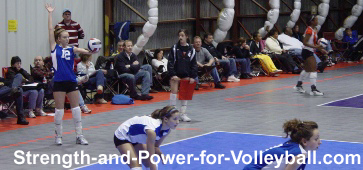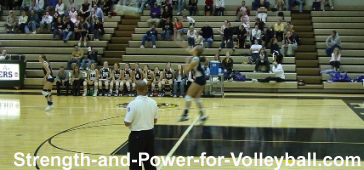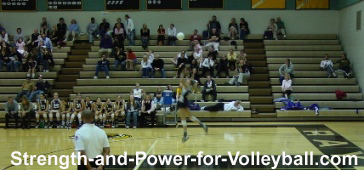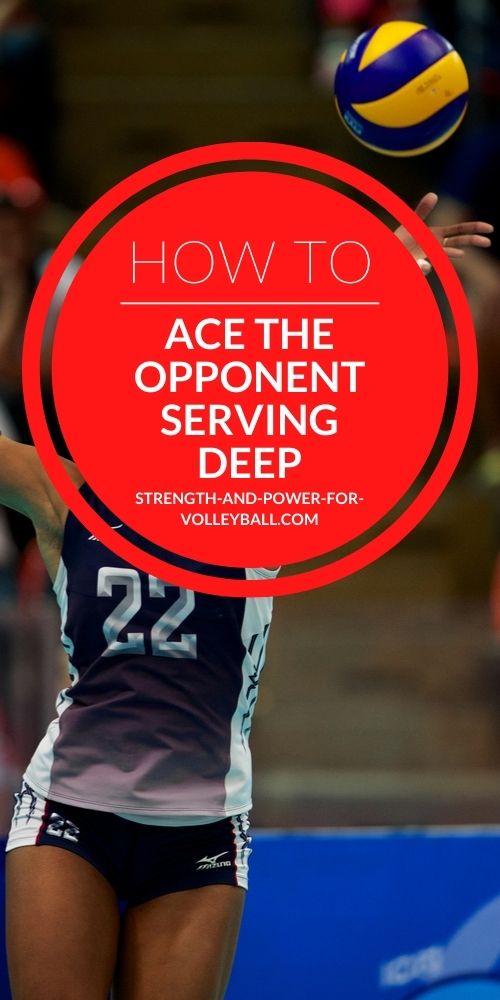Volleyball Serving Tips
Tactics for Float, Zones, and Jump
Volleyball serving tips can make a huge difference in the outcome of a volleyball match.
However, deciding what serve to use and when to use it can be difficult.
Volleyball Serving Tips for Effective Serving
Know your opponents
It's helpful to know ahead of time the other teams strengths and weaknesses passing. Know who the weakest passer is in each rotation.
One passer might not move very well in a particular direction when passing. One passer may have more difficult with a particular type of serve than another.
It's important to understand how your opponents are lined up and what they are trying to accomplish.
Take your opponents out of system
Serve in a way that makes your opponents do what they dont want to.
For example, if a front player is lined up to pass as part of the serve receive, it may be an effective strategy to get them to pass the ball. The more involve they are in passing, the more difficult it may be for them to prepare and execute an attack hit.
If you serve a hitter passing that likes to take a big approach, you could serve them short. If they like to get far outside to approach, you could serve them more inside the court.
The best servers are well prepared
When it comes to serving, servers need to know their own strengths and weaknesses serving, and the strengths and weaknesses of their opponents passing. Servers need to recognize how effect a serve was, and what serve to serve next.
Strategies for serving should be part of every team's game plan. Executing an effective serving strategy is the one way that a team can take control of a match.
Volleyball Serving Tips for Float Serves
Possible advantages to serving deep
- Serving deep is effective against shorter players. If you serve a floater low and deep, shorter players will have more trouble passing the ball. If you get the ball to the deep corners they will have even more trouble passing because they will have to move sideways or reach higher to pass.
- Serving the ball to a spot that forces a front row player to make a pass from deep can be an effective strategy. This is a reason why it's a good idea to know who your opponent's front row players are.If you see them lined up to pass in serve receive, it might be a good idea to try and get them to move deep to pass the ball. By pushing them deep, you may keep them from attacking (at least make it more difficult).
- Its often easier to get a good floating action on the ball when you serve deep because in order to serve deep you must hit the ball harder.
- Serving deep is a good strategy even if you don't know where the best place to serve is. Most passers don't have as much experience passing deep balls because most servers don't ever serve deep all the time. Servers don't serve deep all the time because they haven't developed the philosophy to do so. This is mainly due to the attitude (serving philosophy) of both coaches and players. A coach's attitude towards serving and how capable they think their players are of serving, highly influences their teams attitude towards serving. If coaches would take the time to have their teams practice serving, players would develop the strategies necessary to serve to any spot on the court.
Possible advantages to serving short
- You may force a front row player to become a passer. By forcing front row players to pass it can make your opponents change their offensive strategy, especially if they are run a quick offense.
- A particular passer may want to take the serve with their hands. This will be much more difficult to do if the serve is short.
- Passing short serves can be more difficult because passers often need to pass the ball in a certain way to allow their setters time to get in good position to set.
Make players move
Making passers move to pass is always a good strategy because...
- The more difficult it will be getting in good position to pass
- The more players will have to communicate which will make it more difficult to pass
- You may mess up your opponents system of offense
Volleyball Serving Tips for Jump Serves
Possible advantages to jump serving deep
- Jump serves that go deep can be difficult to pass because it often looks like the ball is going to be out.
- Servers have an advantage serving really hard hit jump serves deep because the ball will drop a lot more than when serving floaters.
- Passers have difficulty passing deep jump serves because of how quickly they must react and judge whether the ball is going to be in or out.
Possible advantages to jump serving short
- Jump serving short can be deceptive. Many passers aren't used to seeing short jump serves and the serve often looks like a regular jump serve because it is often difficult to tell the ball is dropping.
- Jump serving short can be effective because the ball may drop quicker than a float serve which catches the passers off guard.
- Like short float serves, short jump serves can effectively take your opponents offense out of system.
Make players move
When jump serving, making passers move is important. Jump serving right to a passer can sometimes be the easiest serve to pass. On the other hand, making passers move to pass a jump serve can be the most difficult ball to pass.
Volleyball Serving Tips for Hitting Zones
There will be days when a server is having trouble serving effective floaters and jumpers. They still need to have a method for serving their opponents tough. Placing serves can be an effective and even easier method of serving tough serves.
Hand signals for spot serves
Coaches may come familiar with opposing teams strength and weaknesses passing. Coaches may elect to use hands signals for signaling to players where to serve.
Coach's signal servers based on their judgment of where it is most strategically beneficially to serve in a particular rotation. Signaling can be helpful to players that are inexperienced with knowing where to place serves.
Servers need to practice being creative
No one knows better what serve to serve and where to place it than the server. A server may recognize a weakness in their opponents passing. At times a server is more confident about serving a particular serve than another and coaches should encourage servers to go after a weakness in the opponents passing strategy if possible.
For this reason, when teaching strategies for serving, players should be given the opportunity to be creative when serving.
Every server is unique and should developing their own serving skills.
The best servers use their instincts when deciding how they are going to serve and what serving strategy they are going to use.
If you enjoyed these tips and would like to keep it close to you at any time, just save this pin to your Pinterest Volleyball Training Board
Volleyball Serving Tips Related Pages
Volleyball › Volleyball Strategies › Volleyball Serving Tips



